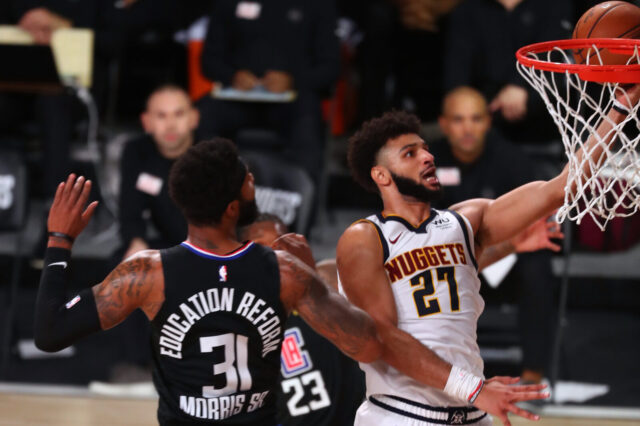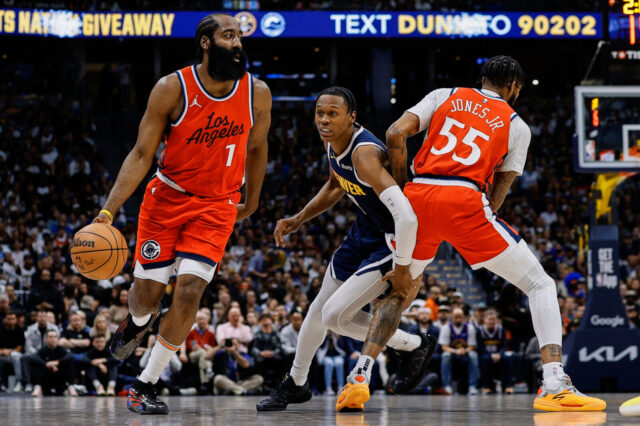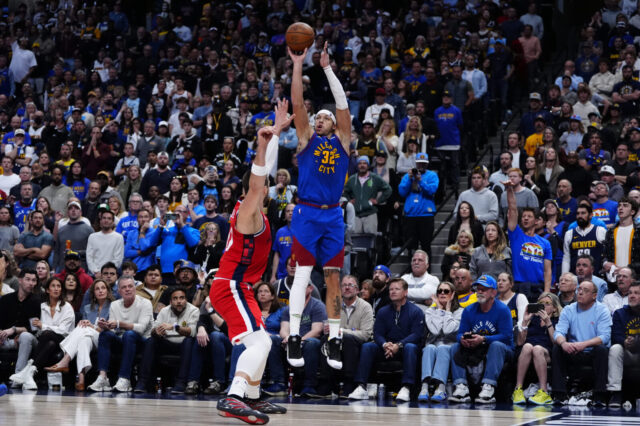Patience, even when you’ve dug a hole
The Denver Nuggets have enough firepower on offense that they can get a great shot on any possession if they trust their ball movement and are patient enough in the half court to hunt for an open look. Talented teams can find B+ shots early and often, it’s the A+ shots that often take an extra pass, cut, or screen to manifest. When shots are falling and the offense is rolling, patience comes easy. But when shots are not falling and the team runs into a collective cold spell, patience can be a bit more elusive.
On Saturday against the Indiana Pacers, the Nuggets shot just 1/9 from behind the three-point arc in the first quarter and found themselves with a double-digit lead at home yet they still opened the 2nd quarter with this beautiful possession.
Paul Millsap had a B+ look, as did Jamal Murray. But everyone trusted their ball movement to find the A+ look and that is why this possession resulted in an open corner three from one of the team’s best shooters. This ball movement also creates a secondary benefit beyond simply creating the open shot: it makes the defense work (and think). Just watch how many times Thaddeus Young changes defensive assignments. He is the player most responsible for closing out on Malik Beasley but by the time the ball swings to the corner, seven passes and four screens have forced Young to transition between several quick defensive reads. He comes up one read short and Denver gets the open bucket.
Jokic screens his own man
The Nuggets finished the 2nd quarter on a 13-2 run that was sparked by this possession. Keep an eye on Nikola Jokic as he sets a screen for Murray by blocking his own man, Myles Turner, rather than releasing to screen the defender guarding Murray. The Oklahoma City Thunder have had success using this exact screen but it’s interesting that Jokic made this read in real time rather than off of a scripted action.
Second effort on defense
One of the core tenants from the gospel of Michael Malone is that multiple efforts are essential for an effective defense. Schemes and gameplans matter but they are all irrelevant if a team is unwilling to give multiple efforts. In the clip below, the Pacers do a great job of setting a flare screen for a shooter, one of my favorite screens out of a post-up. In the first clip, Jokic and Gary Harris are slow to recognize the screen and Darren Collison gets a wide open three-pointer. Note: watch how Turner times this screen because it’s a thing of beauty. Rather than sprint toward Harris right away, he waits for the post player to put the ball on the court before sneaking into a spot where he knows he can surprise Harris once the kickout comes.
In the second clip, Millsap and Will Barton are also late recognizing the flare screen but Millsap runs out at the shooter anyway, running him off of the line. Sometimes the only difference between a stop and a score is that second effort.
Late Reads
In the clip below, Millsap is late taking advantage when his defender sags deep into the paint. Teams do this against Draymond Green and the Golden State Warriors since Green is often the weakest link as a one-on-one scorer and three-point shooter but Draymond has learned that defenses sagging off of him creates another type of advantage: the quick dribble handoff. When a big dribbles into a handoff with a shooter, the player defending the big needs to step up to the level of the screen to prevent an open shot off of the handoff or an easy dribble into the free-throw line.
Here, Millsap makes that right read but he’s a second too late, allowing his defender to catch up to the play and causing the handoff to occur a few steps too far toward the center of the court. Tiny details matter with these types of actions. A one-second delay and being five feet too far in one direction is the difference between an open shot and a Mason Plumlee desperation three-pointer.
Over-anticipating on defense and communication
Mason Plumlee has been really good all year at identifying when the Nuggets are caught with a “mouse in the house.” In the clip below, however, he over-anticipates Denver’s vulnerability by committing to the switch too early, allowing the Pacers to get a wide open dunk. And while Plumlee could’ve timed the switch (or double-team) a bit better, it’s also clear that he and Malik Beasley were not on the same page.
Plumlee allowing post players to get to their spot
Defending the post one-on-one requires two areas of focus: timing to contest the shot attempt and forcing the scorer away from their favorite spots. Smart scorers like Jokic are good at getting their shot over a defender when they are able to get to their spots on the court. More athletic low-post scorers are less dependent on getting to their spots but are more susceptible to defenders with great timing and athleticism. Great defenders can focus on both skills.
One tendency Plumlee has when isolated in the post is that he seems to focus much more heavily on the former and less on the latter. There were three good examples of this against Domantas Sabonis, a smart, finesse player who is deadly when he gets to his right shoulder.
In the first clip, you cans see how Plumlee allows Sabonis to get to his spot on the left block and then falls for the pump fake. He appears to be zeroed in on the timing of the shot knowing that he can out-jump Sabonis.
In the second example, Sabonis is buried deep along the baseline on the right block, out of position to get to his right shoulder but Plumlee inexplicably conceded to middle of the floor for Sabonis to get to his favorite spot on the opposite block.
In the third example, Plumlee gets the wrong end of a 50/50 call but he was placed in that position by once again allowing Sabonis to turn toward his right shoulder.
Plumlee is a great all-around defender but this habit on one-on-one defense in the post is an area of vulnerability for him. He ranks in just the 27th percentile defending the post this season, according to Synergy and has ranked in the bottom half of the league on post-up defense in each of his last five seasons.


